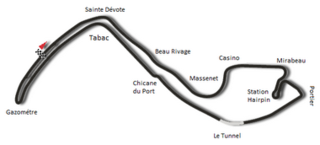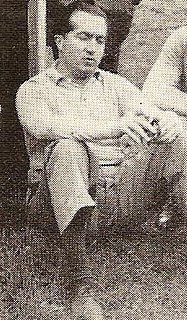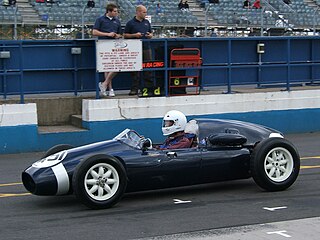Brabham is the common name for Motor Racing Developments Ltd., a British racing car manufacturer and Formula One racing team. Founded in 1960 by Australian driver Jack Brabham and British-Australian designer Ron Tauranac, the team won four Drivers' and two Constructors' World Championships in its 30-year Formula One history. Jack Brabham's 1966 FIA Drivers' Championship remains the only such achievement using a car bearing the driver's own name.

Sir John Arthur Brabham was an Australian racing driver who was Formula One World Champion in 1959, 1960, and 1966. He was a founder of the Brabham racing team and race car constructor that bore his name.

Maurice Bienvenu Jean Paul Trintignant was a motor racing driver and vintner from France. He competed in the Formula One World Championship for fourteen years, between 1950 and 1964, one of the longest careers in the early years of Formula One. During this time he also competed in sports car racing, including winning the 1954 24 Hours of Le Mans race. Following his retirement from the track Trintignant concentrated on the wine trade.

The 1958 Argentine Grand Prix was a Formula One motor race held on 19 January 1958 at Autodromo Municipal Ciudad de Buenos Aires Circuit. It was race 1 of 11 in the 1958 World Championship of Drivers and race 1 of 10 in the 1958 International Cup for Formula One Manufacturers. The race was the sixth Argentine Grand Prix. It was held on the #2 variation of the circuit. The race was held over 80 laps of the four kilometre circuit for a total race distance of 313 kilometres.

The 1958 Monaco Grand Prix was a Formula One motor race held on 18 May 1958 at Monaco. It was race 2 of 11 in the 1958 World Championship of Drivers and race 2 of 10 in the 1958 International Cup for Formula One Manufacturers. The race was the 16th Monaco Grand Prix and was held over 100 laps of the three kilometre circuit for a total race distance of 314 kilometres.

The 1959 Formula One season was the 13th season of FIA Formula One motor racing. It featured the 1959 World Championship of Drivers and the 1959 International Cup for F1 Manufacturers, contested concurrently over a nine-race series which commenced on 10 May and ended on 12 December. The season also included a number of non-championship Formula One races.

The 1958 Formula One season was the 12th season of Formula One motor racing. It featured the 1958 World Championship of Drivers which commenced on 19 January 1958, and ended on 19 October after eleven races. This was the first Formula One season in which a manufacturers title was awarded, the International Cup for F1 Manufacturers being contested concurrently with the World Championship of Drivers with the exception of the Indianapolis 500 which did not count towards the Cup. Englishman Mike Hawthorn won the Drivers' title after a close battle with compatriot Stirling Moss and Vanwall won the inaugural Manufacturers award from Ferrari. Hawthorn retired from racing at the end of the season, only to die three months later after a road car accident. It was the first of only two occasions in Formula One history where a driver won the championship having won only one race in the season, the other being Keke Rosberg in 1982.

The 1952 Formula One season was the sixth season of FIA Formula One motor racing. In comparison to previous seasons, the 1952 season consisted of a relatively small number of Formula One races, following the decision to run all the Grand Prix events counting towards the World Championship of Drivers to Formula Two regulations rather than Formula One. The Indianapolis 500, which also counted towards the World Championship, was still run to AAA regulations as in previous seasons.

Masten Gregory was an American racing driver. He raced in Formula One between 1957 and 1965, participating in 43 World Championship races, and numerous non-Championship races. He was also a successful sports car racer, winning the 1965 24 Hours of Le Mans.
Frederick Roberts Gerard was a racing driver and businessman from England. He participated in numerous top-level motor racing events on either side of World War II, including eight World Championship Formula One Grands Prix, scoring no championship points.
Ivor Léon John Bueb was a British professional sports car racing and Formula One driver from England.
Stuart Nigel Lewis-Evans was a British racing driver from England. He participated in 14 Formula One World Championship Grands Prix, debuting on 19 May 1957. He achieved two podiums, and scored a total of 16 championship points. He also achieved two pole positions.

The Lotus 49 was a Formula One racing car designed by Colin Chapman and Maurice Philippe for the 1967 F1 season. It was designed around the Cosworth DFV engine that would power most of the Formula One grid through the 1970s. It was one of the first F1 cars to use a stressed-member drivetrain to reduce weight, and the first to be widely copied by other teams.
Rob Walker Racing Team was a privateer team in Formula One during the 1950s and 1960s. Founded by Johnnie Walker heir Rob Walker (1917–2002) in 1953, the team became F1's most successful privateer in history, being the first and only entrant to win a World Championship Formula One Grand Prix without ever building their own car.

The Brabham BT19 is a Formula One racing car designed by Ron Tauranac for the British Brabham team. The BT19 competed in the 1966 and 1967 Formula One World Championships and was used by Australian driver Jack Brabham to win his third World Championship in 1966. The BT19, which Brabham referred to as his "Old Nail", was the first car bearing its driver's name to win a World Championship race.

The Cooper T51 was a Formula One and Formula Two racing car designed by Owen Maddock and built by the Cooper Car Company for the 1959 Formula One season. The T51 earned a significant place in motor racing history when Jack Brabham drove the car to become the first driver to win the World Championship of Drivers with an engine mounted behind them, in 1959. The T51 was raced in several configurations by various entrants until 1963 and in all no less than 38 drivers were entered to drive T51s in Grand Prix races.
The 1958 Australian Drivers' Championship was a CAMS sanctioned Australian motor racing competition for drivers of Formula Libre cars. It was the second Australian Drivers' Championship. The title was contested over a nine race series with the winner awarded the 1958 CAMS Gold Star.

Ecurie Bonnier, Ecurie Suisse, Joakim Bonnier Racing Team and Anglo-Suisse Racing Team were names used by Swedish racing driver Joakim Bonnier to enter his own cars in Formula One, Formula Two and sports car racing between 1957 and his death in 1972. Commonly the vehicles were entered for Bonnier himself, but he also provided cars for a number of other drivers during the period.

Owen Richard Maddock was a British engineer and racing car designer, who was chief designer for the Cooper Car Company between 1950 and 1963. During this time Maddock designed a string of successful racing cars, including the Formula One World Championship-winning Cooper T51 and T53 models.

The Cooper T45 was a open-wheel formula racing car, developed and built by the Cooper Car Company in 1958, and designed by Owen Maddock. It competed in Formula 2 racing as well as in Formula One racing, where it won one World Championship Grand Prix, the 1958 Monaco Grand Prix, being driven by Maurice Trintignant.













